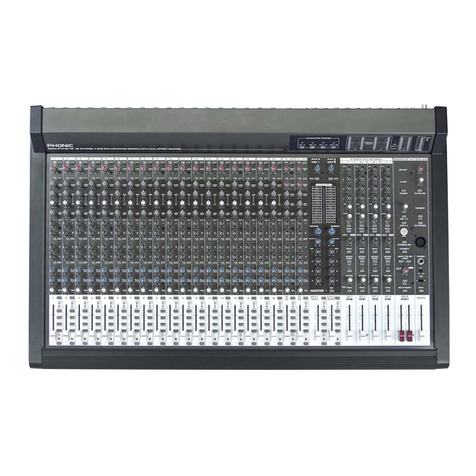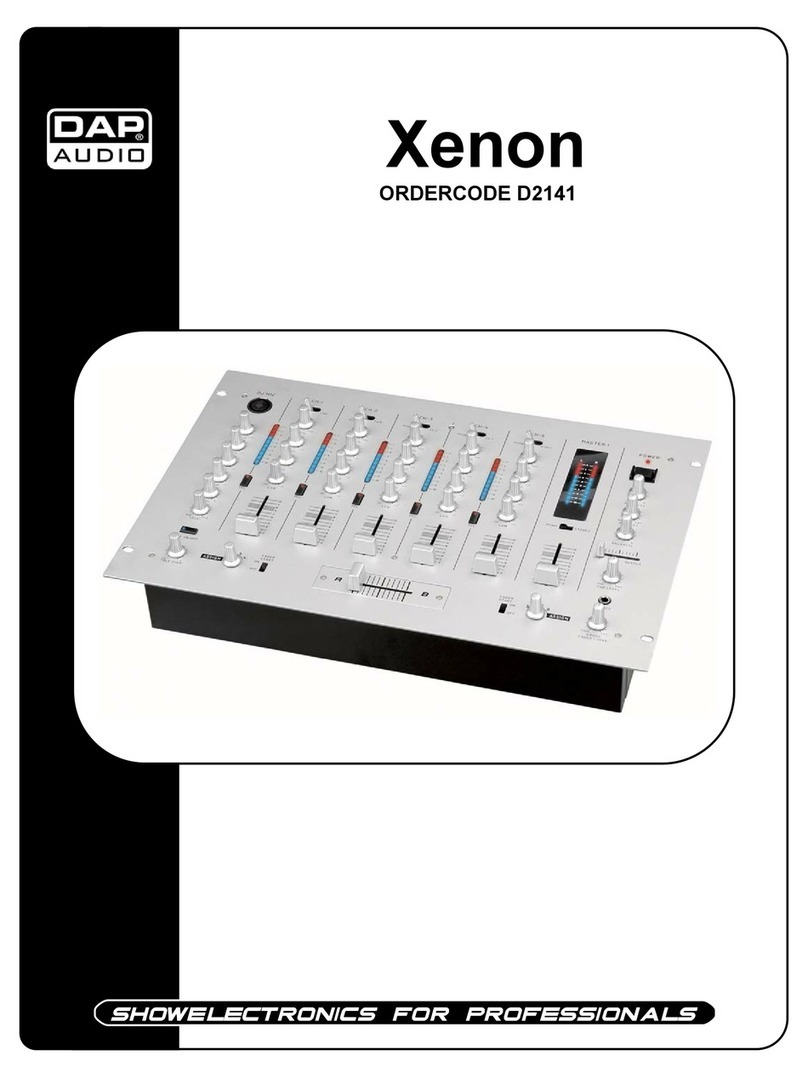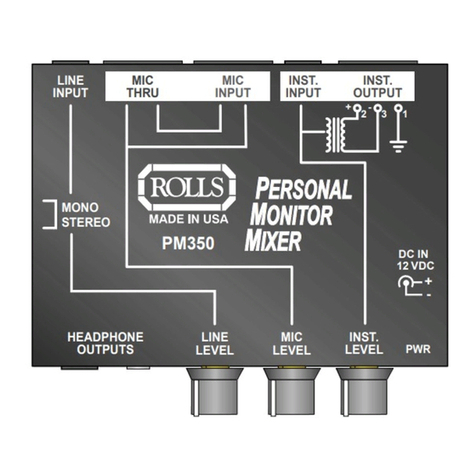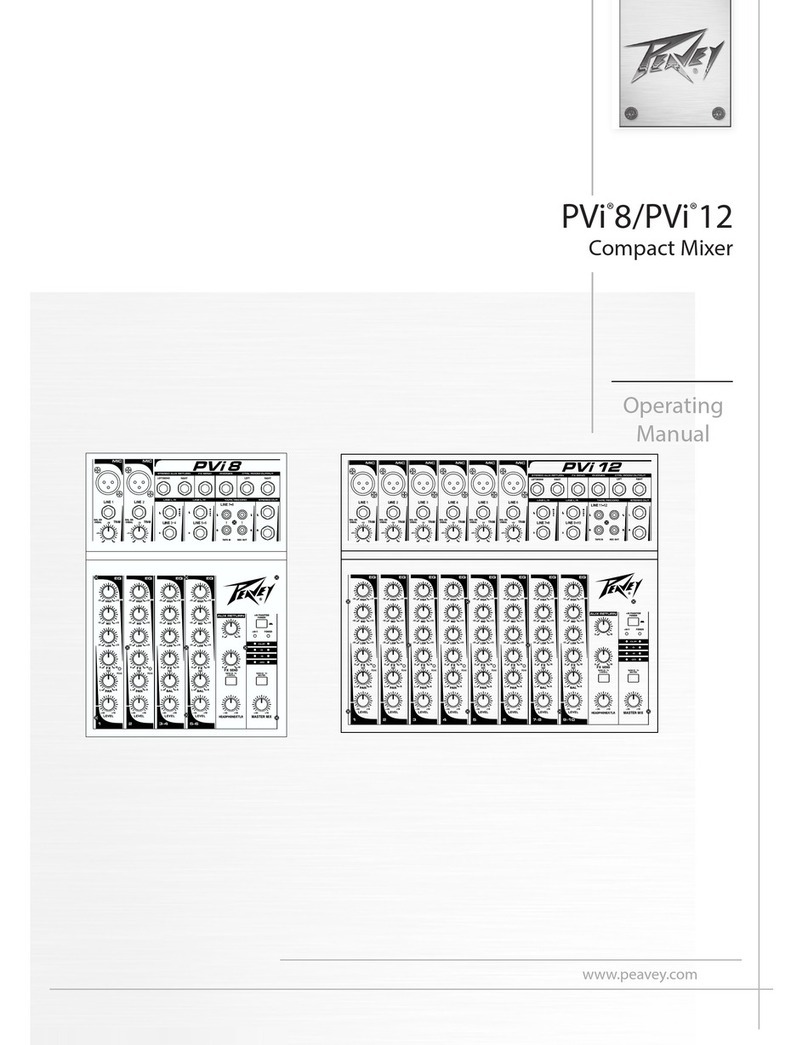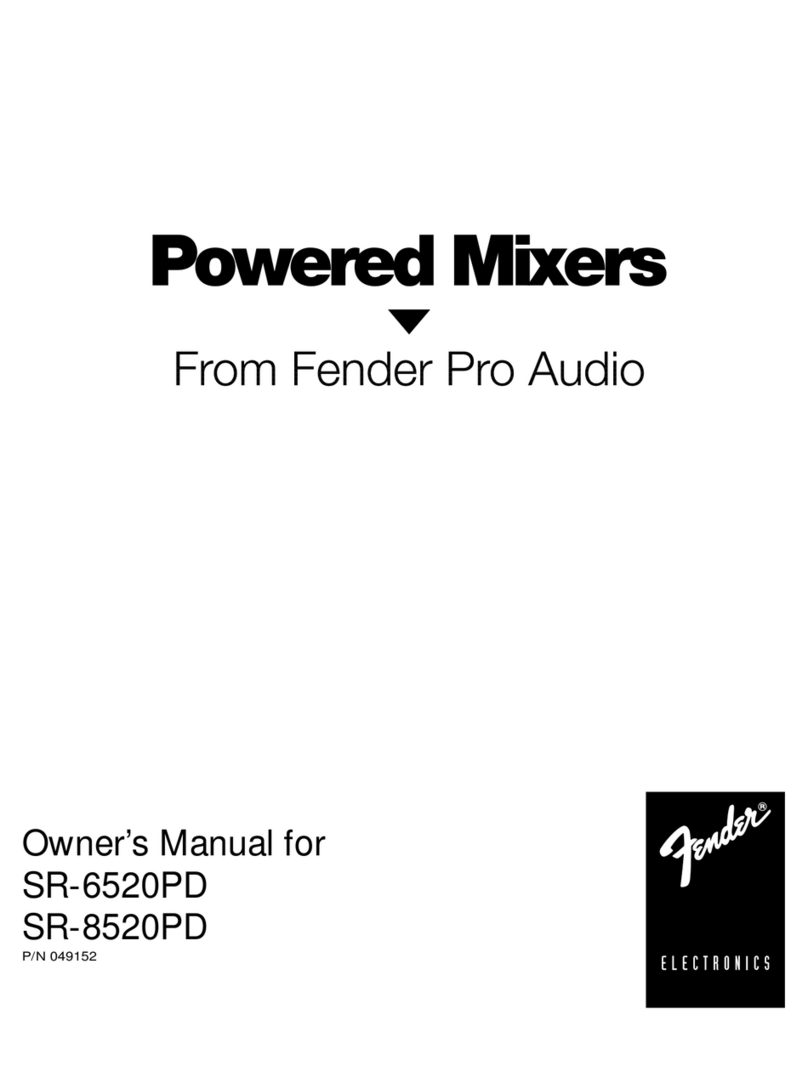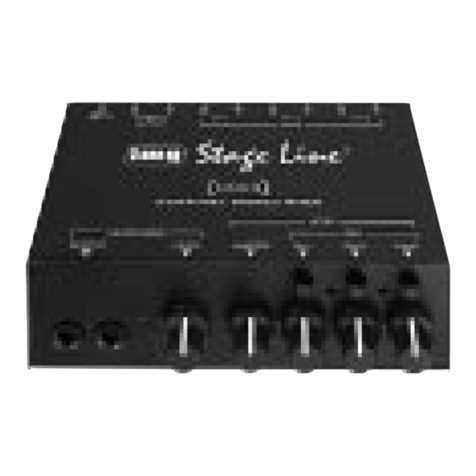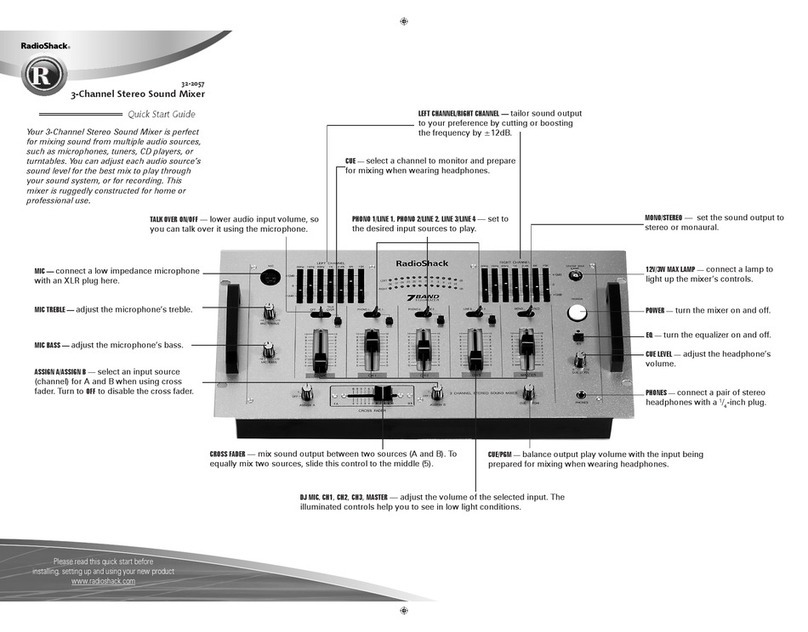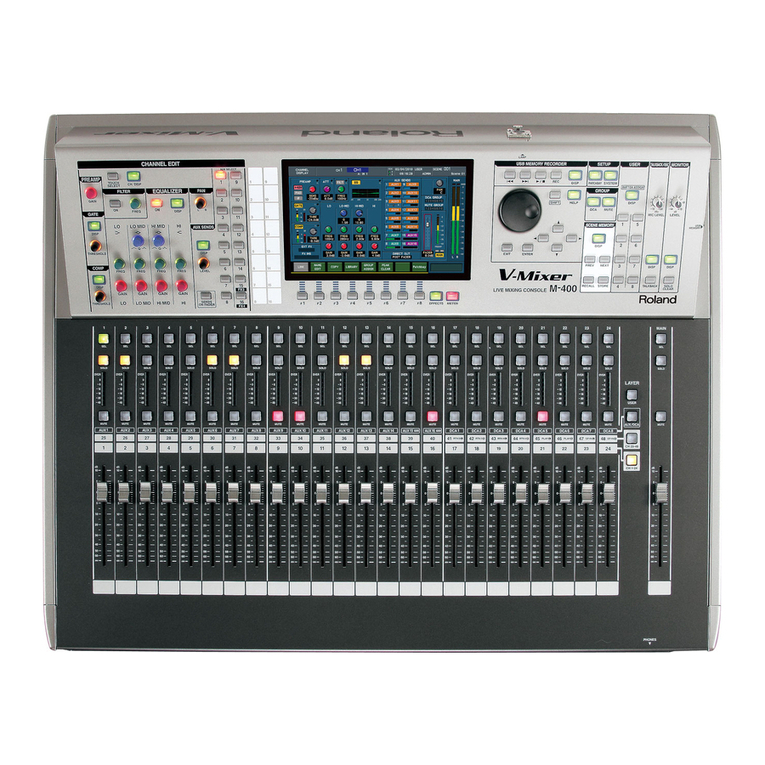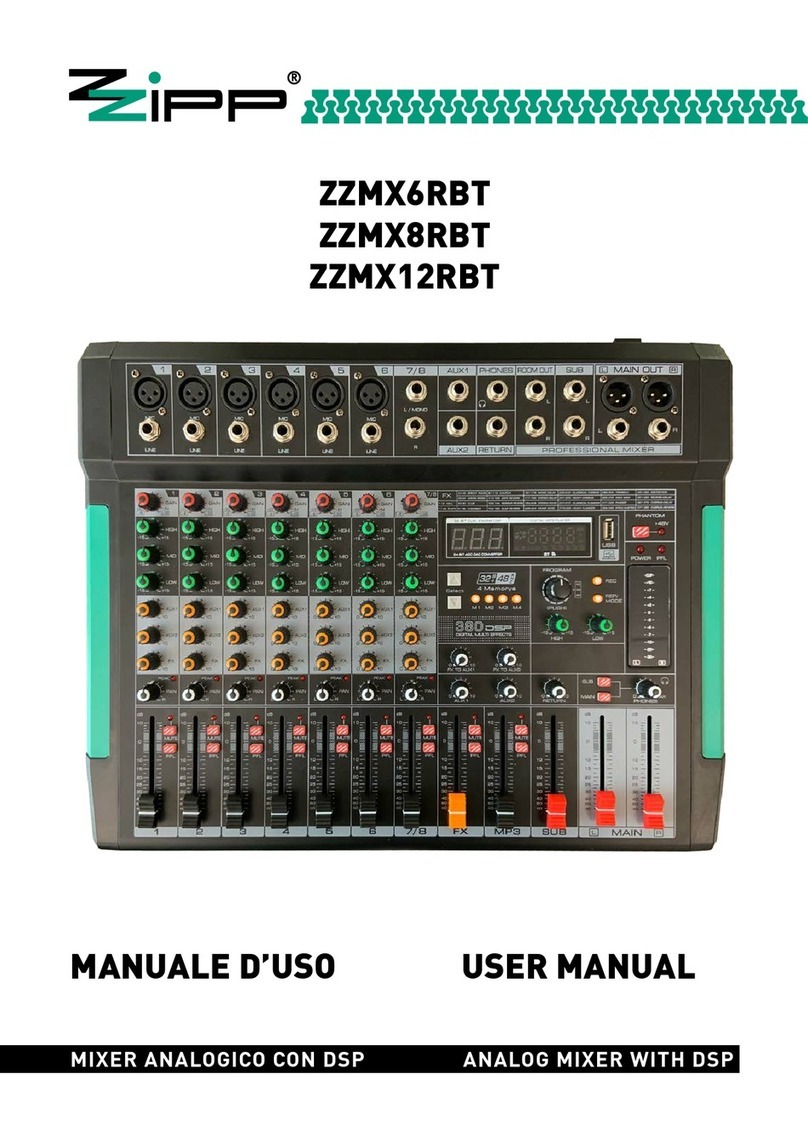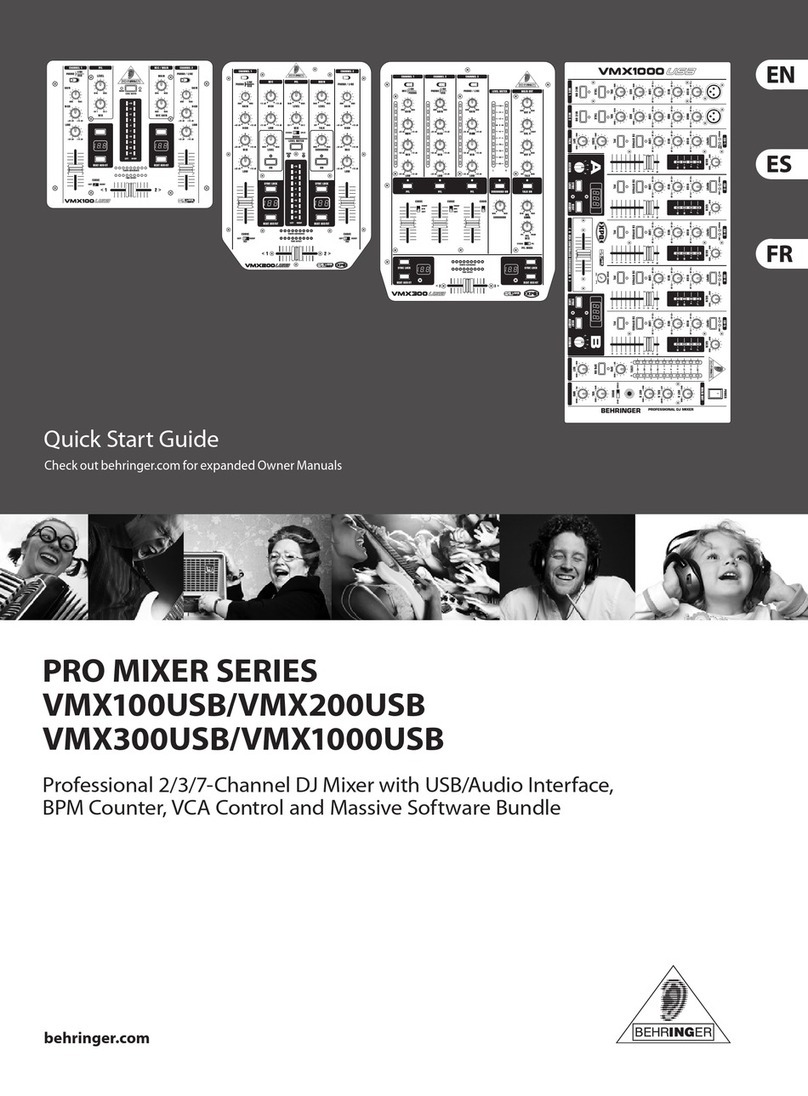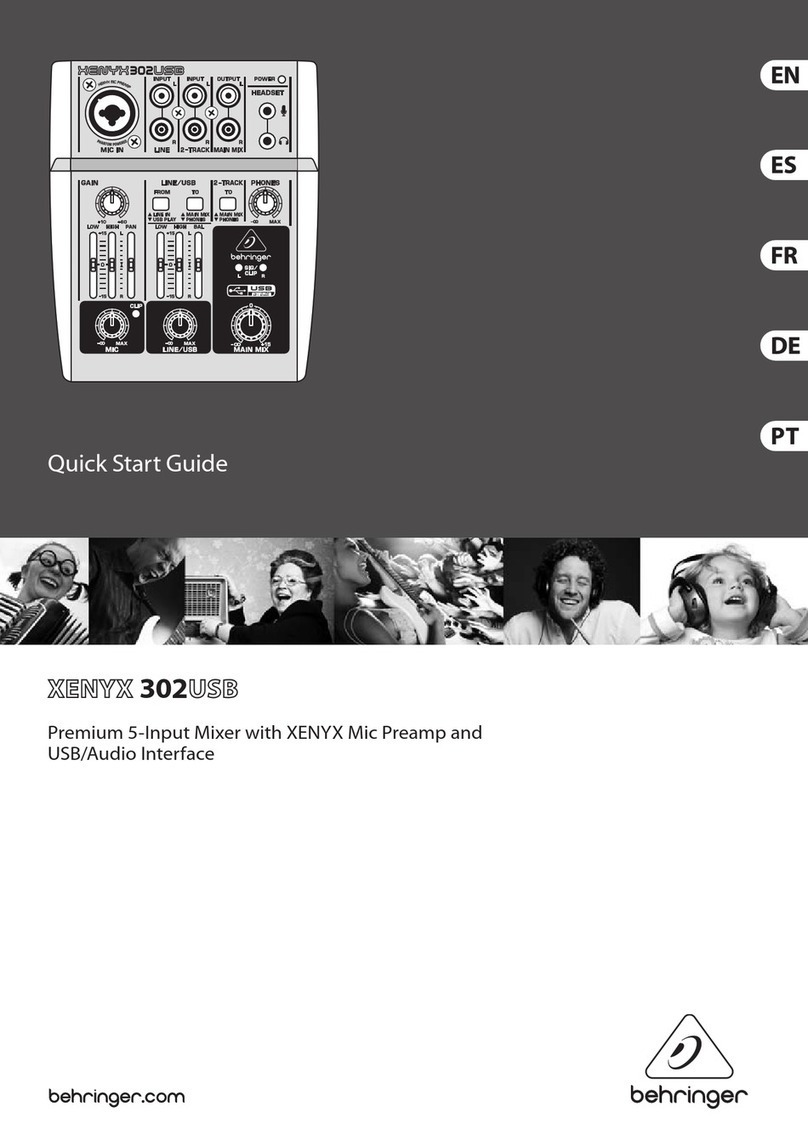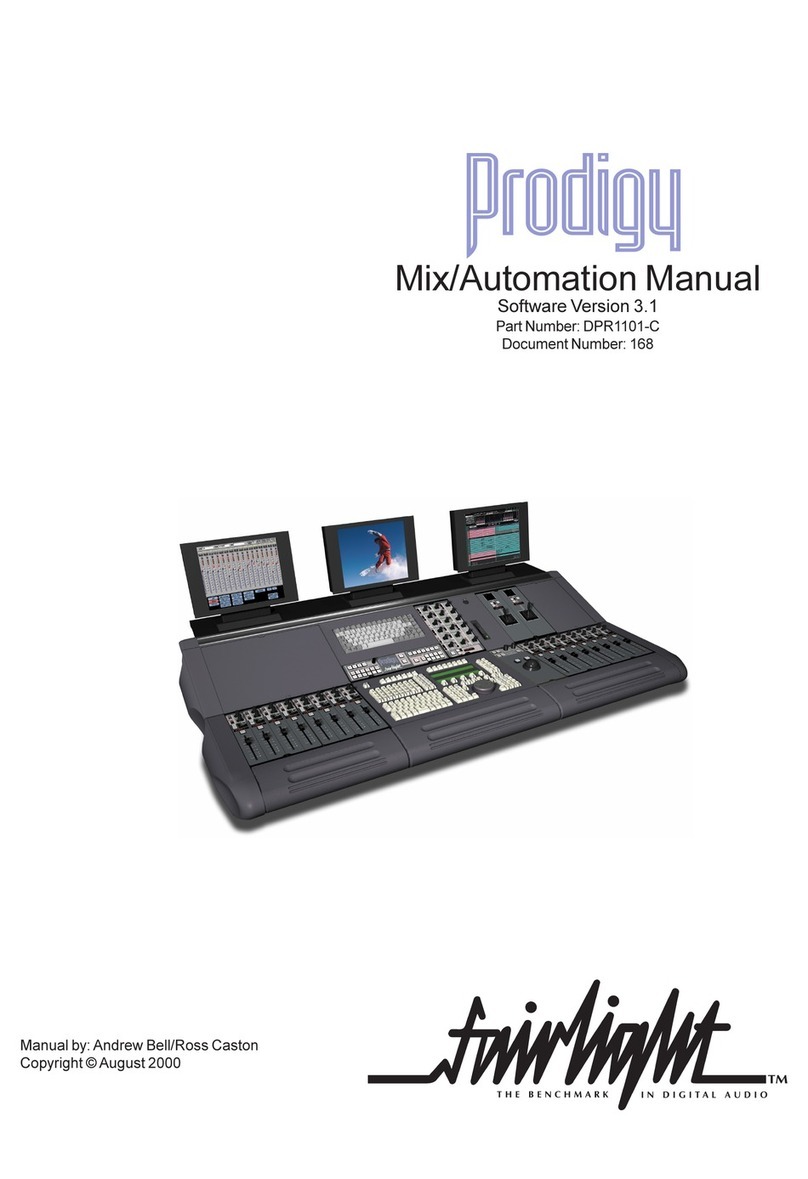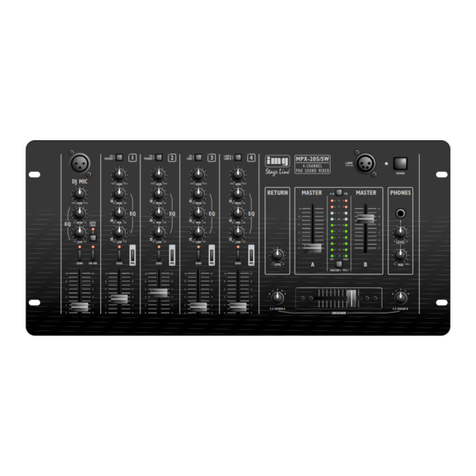Phonic MU 1705 User manual

MU 1705 Compact Mixers

PHONIC CORPORATION
Page 2 MU1705 USER
’
S MANUAL
This triangle, which appears on your
component, alerts you to the presence
of uninsulated “ dangerous voltage” in-
sidetheenclosurethatmaybesufficient
to constitute a risk of shock.
This triangle, which appears on your
component, alerts you to important op-
eratingandmaintenance instructions in
this accompanying literature.
SAFETY PRECAUTIONS!
WARNING - TO REDUCE THE RISK OF FIRE OR ELECTRIC SHOCK, DO NOT EX-
POSE THIS UNIT TO RAIN OR MOISTURE.
Do not allow water or liquids to be spilled into this unit. If the unit has been exposed to rain or liquids,
please unplug the power cord iMUediately from the outlet (with DRY HANDS) and get a qualified service
technician to check it. Keep this unit away from heat sources such as radiators, heat registers, stoves,
etc. that produce heat.
The unit contains no user-serviceable parts. Refer all servicing to a qualified
CAUTION:
TOREDUCETHE RISKOFELECTRIC SHOCK, DONOTREMOVECOVER(OR BACK).
NO USER-SERVICEABLE PARTS INSIDE. REFER ALL SERVICING TO QUALIFIED
SERVICE PERSONNEL.
Keep this unit clean by using a soft dry brush and occasionally wiping it with a damp cloth. Do not use any
other solvents, which may cause damage to paint or plastic parts. Regular care and inspection will be re-
warded by a long life and maximum reliability.
Your Phonic MU1705 was carefully packed in the factory and the packing box was designed to protect the
unit from rough handling. We recoMUend that you carefully examine the packaging and its contents for any
signs of physical damage, which may have occurred in transportation.
If the unit is damaged: Notify your dealer and the shipping company iMUediately. Claims for damage or
replacement may not be granted if it is not reported properly or in a timely manner.
SAFTY PRECAUTIONS
service engineer through a Phonic dealer.

PHONIC CORPORATION Page 3
MU1705 USER
’
S MANUAL
INTRODUCTION..................................................4
FEATURES...........................................................4
GETTING STARTED............................................4
CONVERTING TO RACKMOUNT MODE............5
CONNECTING IT UP...........................................6
TYPICAL CONNECTING LEADS.........................7
UNBALANCED & BALANCED.............................8
CHANNEL STRIP DESCRIPTION .......................9
GAIN.................................................................9
EQUALIZERS...................................................9
AUX / EFX SECTION......................................10
PAN.................................................................10
PEAK/-20/PFL.................................................10
L/R OR GP (ROUTING SWITCH)................... 11
CHANNEL FADER.......................................... 11
STEREO CHANNELS 6-11.............................12
AUX RTN........................................................12
EFX RTN.........................................................12
2T RTN ...........................................................12
MASTER SECTION DESCRIPTION.............13
AUX OUT...................................................13
EFX OUT..........................................13
PHONES....................................................13
GROUP TO L/R.........................................13
GROUP 1/2 FADER.............................13
MASTER DISPLAY...........................14
MONO LEVEL CONTROL.........................14
MAINL/ROUTPUTFADER..........................14
REAR PANEL DESCRIPTION........................14
PHANTOMPOWERSWITCH......................14
POWER SWITCH........................................14
INITIAL SET UP.....................................15
APPLICATIONS.....................................16
1:LIVE SOUND REINFORCEMENT............16
2:SUB MIXING............................................17
3:MUSIC CLUB..........................................18
DIMENSIONS.................................................19
SPECFICATIONS............................................20
SYSTEM BLOCK DIAGRAM....................21
APPENDIX:.........................................22
1: SUGGESTED READING....................22
2: GLOSSARY.......................................23
CONTENTS
pP
Phonic reserves the right to improve or alter any information supplied within this document without prior
notice. V2.2 Jun. 8, 2004

PHONIC CORPORATION
Page 4 MU1705 USER
’
S MANUAL
INTRODUCTION GETTING STARTED
1. Check the AC voltage before connecting the
plug. This product is equipped with a 3-
wiregrounding type plug;this is asafety feature
and should not be defeated. Proper grounding
must be practiced to prevent electrical shock to
theoperator, themicrophone user, andany mu-
sicianswhose instruments arewiredto this unit.
Choose the main supply for the sound system
with care, and do not share sockets or earthing
with light dimmers.
2. Positionthemixerwherethesoundcanbeheard
clearly; preferably with the audience.
3. Run audio cables separately from dimmer wir-
ing, using balanced lines wherever possible. If
necessary, cross audio and lighting cables at
right angles to minimize the possibility of inter-
ference. Keep unbalanced cabling as short as
possible.
4. Check your cables regularly and label each
end for easy identification.
5. Before switching on the main power, keep all
the output faders all the way down to prevent
damageor excessive noise causedbybad level
adjustment, wrong wiring, defective cables,or
bad connections.
6. Always turn on the MU1705 mixer before the
poweramplifier; turn offtheMU1705mixerafter
turning off the amplifier.
7. Always turn off the power before connecting or
disconnecting the unit.
8. Never use solvents to clean the unit. Clean with
a soft, dry cloth.
INTRODUCTION / FEATURES / GETTING STARTED
Congratulations on your purchase of the MU 1705
Mixer.TheMU1705is built of ruggedconstruction,
itcanbemountedonastandard19-inchack,which
is ideal for both touring and fixed PA installations.
In order to get the best performance from the MU
1705, please read this user manual carefully, and
retain it for later reference. If you ignore the man-
ualand directly jumpinto the unknown,something
mighthappen and makes afoolout of you.Please,
at least find out what things are different about
this mixer and check if you are familiar with all
its features even if you are an experienced mixer
board user.
FEATURES
5 balanced microphone/line input channels,
two with insert points
3 stereo line input channels
2 stereo line returns
2T input and recording output
1 aux and 1 effect mix send
3 band EQ for each line input channels
PFL for input, AFL for output
60mm high quality linear faders
Dual 13-segments LED level meter
2 audio groups
Stereo main output
Mono main output
+48V phantom power
-20/PFL,PEAKindicatorsoneachinputchan-
nel
AUX SND can be set in PRE or POST fader
Low cut filter on each mono input channel

PHONIC CORPORATION Page 5
MU1705 USER
’
S MANUAL
CONVERTING TO RACKMOUNT MODE
There is an option to meet the requirements of the
engineer who prefers to use a mixer that is installed
on a standard 19”rack. It is simple to install the rack
mount kit by the following procedure:
1. Install the rack mount kit with the 6 screws num-
bers 1-6.
2. Install the mixer on the rack.
CONVERTING TO RACKMOUNT MODE

PHONIC CORPORATION
Page 6 MU1705 USER
’
S MANUAL
CONNECTING IT UP
CONNECTING IT UP

PHONIC CORPORATION Page 7
MU1705 USER
’
S MANUAL
TYPICAL CONNECTING LEADS
TYPICAL CONNECTING LEADS

PHONIC CORPORATION
Page 8 MU1705 USER
’
S MANUAL
UNBALANCED & BALANCED
UNBALANCED & BALANCED
Unbalanced & Balanced Connection
Most of the mistakes in audio installations are
because of incorrect and defective audio connec-
tions.Inorderto perfectly completeyourinstallation;
please pay special attention to the following sec-
tion unless you are already familiar with balanced/
unbalanced operations.
What is an unbalanced system?
You can find this kind of system in most of home
audio-video systems. They have one conductor to
carrythesignal,andanotherconductor for a ground.
Normally, for lower level signals, the ground con-
ductor shields the signal conductor.
What is a balanced system?
A balanced system transmits the signal via 2 con-
ductors plus one ground shielding conductor. The 2
signal conductors carry the same signal but out of
phase. For the balanced input stage, the amplifier
will boost the difference of the 2 signal conductors
andremovetheidentical part (known ascoonmode
signal) of the 2 signals . Because the real signal
is carried by the 2 conductors out of phase, so it
is perfectly carried to the input. At the same time,
interference that occurs during transmission will be
identical (coMUon mode). Because the signal con-
ductorsareruntogether,thereisnochancetheycan
bedifferent,andall the interferencewillbe removed
by the balanced input amplifier.
The difference between 2 operations:
BecauseofthecoMUonmodeinterferenceiMUunity
ofabalanced system, thegroundconductor doesn’t
need to carry any electrical current, which means
theground of the2 connected unitshas an identical
ground level which is vital to an interference free
system. Let’s look back to the unbalanced system.
The signal electrical current goes from the signal
conductor to the ground conductor, and that means
the ground level of the 2 connected units are not
identical. This means the system is much easierto
experience noise interference.Running long cables
is easy for a balanced system but difficult for an
unbalanced system, and lower noise levels are a
constant characteristic of a balanced system. Be-
causeabalancedsystemneeds2conductors for the
signal and 1 conductor for the ground, a minimum
of 3 conductors are needed for wiring a balanced
system.Soadedicatedsystemseparates the ground
and shields the 2 conductors.
Please read following section for properly wiring
balanced and unbalanced systems:
The Correct Wiring for Balanced Operation
Always connect the main power with 3 plugs. Make
sure the power system ground is working properly.
Don’t use a ground insulator plug adapter without
properly connecting the ground individually. This
is vital to making a successful audio system con-
nection.
Always connect the ground pin (PIN 1 in XLR) to
the source unit, and disconnect this pin on the des-
tination unit. This connection topology is to avoid
creating a grounding loop between the signal and
power ground. Utilize only the power ground, be-
cause it always has a lower resistance and better
distribution than the signal ground.
If there is hum, a possible reason is a bad ground
connection for the system. In case you can not find
the fault, try connecting the ground pin of the input
connectors. If the hum is reduced or eliminated,
check your power grounding system. Special at-
tention is needed when you use the equipment
rackswith some distancebetweenthem, and/or use
alargequantityofpoweramplifiers.Checkthepower
ground between the racks and power distribution
stripswithyourelectricalsupplyengineer. Make sure
there is one, and only one, proper ground point for
aaaaaaaaaaaaa
aaaaaaaaaaaaa
aaaaaaaaaaaaa
aaaaaaaaaaaaa
aaaaaaaaaaaaa
aaaaaaaaaaaaa
aaaaaaaaaaaaa
aaaaaaaaaaaaa
aaaaaaaaaaaaa
aaaaaaaaaaaaa
aaaaaaaaaaaaa
aaaaaaaaaaaaa
aaaaaaaaaaaaa
aaaaaaaaaaaaa
aaaaaaa
aaaaaaa
aaaaaaa
aaaaaaa
aaaaaaa

PHONIC CORPORATION Page 9
MU1705 USER
’
S MANUAL
CHANNEL STRIP DESCRIPTION
Two inputs are available to the
mono input channel, via an XLR
connector (normally for micro-
phone sources) or a 3-pole 1/4”
phone jack for higher level signals
such as keyboards, drum ma-
chines, synths or tape machines.
Bothinputsocketsarepermanently
active, and may be used by sim-
ply plugging the source into the
required input. You do not need
to unplug something from the mic
socket if you want to use the line
input. When both the microphone
and line signals are plugged into
any channel from CH1 to CH5,
then the circuit will automatically
be switched to line source.
An unbalanced INSERT is offered
which is a break point in the input
channel signal path. It allows the
signal to be taken out of the mixer,
through an external device and
then brought back into the con-
sole to continue through to the
final output. The insert is a 3-pole
1/4” phone jack, which is normally
by-passed.
When a jack plug is inserted, the
signal path is broken at a point
just
after the high pass filter, but before
theEQsection.Thesignalfrom the
channel appears on the TIP of the
phone plug and is returned on
the RING. The insert point allows
compressors, limiters, effect and
other signal processing units to
be added as required to particular
input channels and because it is
located PRE EQ, noise generated
by the external equipment may be
1. GAIN
This rotary knob adjusts the channel
signal level. Too high, and the signal
willdistort as itoverloadsthe channel.
Too low, and the level of back hiss will
be more noticeable and you may not
be able to get a high enough signal
levelto the outputofthe mixer. Proper
gainorgain settings allow themixerto
workatthebestoperatinglevel.Adjust
thegainwhenthereis a signal present
to the highest level without triggering
the peak LED. That is the most ap-
propriate position.
This gain adjuster has two indications
to match either a microphone or line
inputsignal. When youuse the micro-
phoneinput, please referto the inside
ringfrom0~+60 dB; butwhenyou use
line input, please refer to the outside
ring from -20~+40dB.
Ifyouuseacondensormicrophone, it
isrequiredtosendphantompowerto
it. The global phantom power switch
is located on the rear panel.
All faders (Group 1, Group 2, Mono,
L/R and CH1~11) should be all the
way down when you switch on the
phantom power. In order to prevent
excessive noise to stage monitor
speakers and main speakers,
phantom powered mics should be
plugged in after the phantom power
is switched on.
2. EQUALIZERS
These equalizers are designed to
suit different room acoustics, control
feedback and improve the live PA
sound. No amount of equalization will
correct the frequency response curve
of a poor loudspeaker. Always begin
with all controls in the “0” position and
avoid excessively cutting/boosting
CHANNEL STRIP
DESCRIPTION

PHONIC CORPORATION
Page 10 MU1705 USER
’
S MANUAL
CHANNEL STRIP DESCRIPTION
ments of any particular frequency,
which will limit the system’s
dynamic range or increase the
possibility of an unpleasant feed-
back sound.To make sound more
impressive, a dynamic process is
necessary. Channel inserts are
designed to add-on a compres-
sor, limiter or gate. Please refer to
Phonic PCL3200 or MCL2000 for
further information.
HIGH
Each input channel of the MU1705
has a three-band EQ. Turn the
HIGH to the right to boost high
frequency, adding crispness to
cymbals, vocals and electronic
instruments. Turn to the left to cut
this frequency, reducing sibilance
or hiss. The control has a shelving
response that gives 15dB of boost
or cut at 12KHZ.
MID
This knob provides 15dB of boost
and cut at 2.5k Hz, similar to the
High EQ knob.
LOW
The control has a shelving re-
sponse that gives 15dB of boost
or cut at 80Hz. Add warmth to
vocals or extra punch to guitars,
drums and synths by turning to
the right. Turn to the left to reduce
stage rumble, hum or to improve a
mushy sound.
LOW CUT (CH1~5 only)
Slide down the dip-switch, insert
the 18dB per octave 75Hz low cut
filter in the signal path. This low
It can also be used to cut off low
frequency hum.
3. AUX / EFX SECTION
These rotary faders send out the input
channel signal to AUX or EFX buses.
These are used to set up separate
mixes for a foldback system and
external processing machines and
recording.The AUX send can be set
as either pre-fader (so that the aux
send is independent from the fader,
which is suitable for foldback or moni-
tor) or post-fader (which is suitable for
theprocessor unit; the effectsignalwill
fadeup and downwiththe fader). PRE
or POST AUX signal is selected by a
push button.
The EFX send is always post-fader
and both AUX Send and EFX send
are post EQ.
4. PAN
This control sets the amount of the
channelsignalfeedingtheleftandright
mix buses, and allows you to locate
the source smoothly across the stereo
image.When the controlis turned fully
right or left, you are able to route the
signal to either left or right output.
5. PEAK / -20 / PFL
PEAK
The LED indicators light up when an
excessively high signal level is pres-
ent in the channel. In general, Input
level should be set to the level where
the LED flashes briefly on the loudest
peaks only, if it flashes continuously,
turn the input control down slightly.
This ensures the best possible signal-

PHONIC CORPORATION Page 11
MU1705 USER
’
S MANUAL
CHANNEL STRIP CHANNEL
-20
TheLEDwill come on ifthechannel
receives a signal input higher than
-20 dBu. Both the -20 dBu and the
PFL share the same indicator.
PFL
Pre-Fader-Listening, when the
PFL switch is pressed, the pre-
fadersignalwill be fed tothecontrol
room/headphone output, where it
replaces the selected monitor
source.PFLis veryusefulfor a mix-
ing engineer to monitor individual
channelswithout affectingthe main
mixes, for making adjustments or
tracing problems.
6. L/R OR GP (ROUTING
SWITCH)
The input channel signals may be
routed in stereo to the main output
(L/R)orpairsofGroupbusses(1-2),
by pressing the routing button. The
PANwillalsoaffectthesignalroute.
Turning extremelyleftcanonly feed
Group 1 and extremely right only
feed Groups 2.
7. CHANNEL FADER
A long-throw 60MU linear fader
determines the proportion of the
channel in the mix and provides
a clear visual indication of chan-
nel level.

PHONIC CORPORATION
Page 12 MU1705 USER
’
S MANUAL
CHANNEL STRIP DESCRIPTION
These 3 stereo input channels are de-
signed for a stereo line level signal, from
astereo source suchas keyboards, drum
machines,synths, hi-fiequipmentor DAT
players. They have the same function as
mono channels except for GAIN setting
and balance adjustment. These high
impedance inputs accept 2-pole phone
jacks. Use these inputs for keyboards,
drum machines, synths, tape machine
or processing units. If the source signal
is mono please plug into the left channel
socket only.All of functions are the same
with the mono input channel strip.
8. AUX RTN
TheAUXRTNcontrolsection includes one
knob and one PFL push button. The knob
controls the AUX RTN level. When you
would like to monitor the signal of AUX
RTN, simply depress the PFL button, the
input signal will be fed into CTRL RM.
9. EFX RTN
The EFX RTN control section includes
one knob and one PFL push button. The
knob controls the EFX RTN level. When
you would like to monitor the signal of EFX
RTN, simply depress the PFL button, the
input signal will be fed into CTRL RM.
10. 2T RTN
This knob controls the level sent to the
masterL/R.Whenyouwouldliketomonitor
thesignalfrom the 2TRTN,simplydepress
the PFL button, the input signal will be fed
into CTRL RM.
STEREO CHANNELS 6-11

PHONIC CORPORATION Page 13
MU1705 USER
’
S MANUAL
11. AUX OUT
This control routes a mono sum of the
input channel signal to the AUX bus. It is
separate from the master L/R outputs and
can therefore build additional mix output
for the stage monitor, effect unit or extra
loudspeakers.
12. EFX OUT
This control routes a mono sum of the
input channel signal to the EFX bus. It is
separate from the master L/R outputs and
can therefore build additional mix output
for the effect unit.
13. PHONES
This knob controls the CTRL RM/
headphones level output.
14. GROUP TO L/R & AFL
GROUP TO L/R
You can assign the GROUP 1/2 signal to
MAIN L/R. If you depress the L/R or GP
button of any input channel then the input
signalwillbefedtoGROUP1/2.Moreover,if
youwould like the inputchannel signal to be
mixedby theMAIN L/R, then it isnessary to
depress the GROUP 1/2 to L/R button.
AFL
This AFL button can send the GROUP 1/2
signal to CTRL RM or PHONES for mon-
itoring; this signal will then be affected by
GROUP 1/2 faders.
15. GROUP 1/2 FADER
Along-throw 60mm linear fader determines
the proportion of the group signal in the mix
and provides a clear visual indication of
MASTER SECTION DESCRIPTION
MASTER SECTION DESCRIP-
TION

PHONIC CORPORATION
Page 14 MU1705 USER
’
S MANUAL
16. MASTER DISPLAY
This blue PWR LED will light when the power is
on.When you would like to monitor any input chan-
nel or output signal, depress its PFL button , or its
AFLbutton in GROUP, and the master level meter
will show you the signals which you have chosen.
In addition, the green PFL LED indicator will light
up.The 13-segment LED meter shows the level of
master mix L and R in the stereo mode.
17. MONO LEVEL CONTROL
The MONO output signal mixes the pre-
fader signal of the MAIN L/R. You can use
this signal as the center cluster or apply it to
another area. This knob controls the level of
the mono mix output.
18. MAIN L/R OUTPUT FADER
These60MUlong faders adjust theoutputlevel
of the MAIN L/R.
A +48V global Phantom Power master switch
located in the rear panel, available for condense
microphoneon each microphoneinput channel.All
faders(CH1~11,Group1,Group2,L/RandMONO
) should be all the way down when this phantom
powerisswitched on. Inordertoprevent excessive
noise to stage monitor speakers and main speak-
ers, you should not have condensor microphones
pluged in when the +48V master switch is on.
19. POWER SWITCH
Before you turn on the power switch, please pull
down all the faders to the bottom to prevent un-
wanted transient high level signals from destroying
your audio system. The power on LED will light up
in the display section when you turn on the power
switch.Thedescriptionbesidethepowersocket tells
youthepartnumberofpowersupplyadaptorforyour
local main power.
18. PHANTOM POWER SWITCH
REAR PANEL DESCRIPTION
REAR PANEL DESCRIPTION

PHONIC CORPORATION Page 15
MU1705 USER
’
S MANUAL
INITIAL SET UP
Thisprocedureis very important. Evenifyoudon’t
like to read manuals, please read this section.
After you connect up the system, you are ready
to set the initial set up for every input channel.
The matching of every input trim to the signal
source is crucial; every detail will affect the final
outputof the mixer. Basically,theinput sensitivity
adjustmentfor the channelfader and outputfader
are the main factors. You should try to set only
as much microphone trim as required to achieve
good balance between signals. If the input trim is
set too low, you will not get enough gain on the
faders to push the signal up to an adequate level.
If the input trim is set too high, the channel fader
will need to be pulled down in compensation, but
it leaves a greater risk of feedback because small
fadermovementswillhavea very significant effect
on output level. Certainly, the limited fader travel
pathwillnotbesuccessfulinthemixingprocedure.
Please use the following set up procedure. Don’t
use the old way: turning the output up until they
clip and then backing off.
Set all faders and trim controls all the way
off.
Anycondenser microphones shouldbecon-
nected before the +48V phantom power is
switched on.
Set power amplifier levels to 70%.
Set the Headphones level to about 50%.
If you want to hear what you’re doing later,
plug your headphones into the phones
output socket.
Depress the MUTE button.
Push in the PFL button.
Set EQ control to the center position.
Set PAN and BALANCEknobs tothe center
position.
You need headphones to continue.
Apply a typical performance level signal,
monitoring the level on the LED meter.
Adjust the input trim until the meter shows
aroundthe0dBuposition,withoccasionalpeaks
to the first red LED at maximum source level.
Thisallows enough headroomtoaccoMUodate
peaks and the maximum level for normal op-
eration. You can listen to them through your
headphones.
Formicrophonesources,thegaincontroladjust-
ment will depend on what kind of microphone
youuse, normally turnthetrim clockwise to2~3
o’clock. But please ask the singer to perform
outloud, don’t whisper, if they do not sing at
a normal level while you’re doing the sound
check, you might drive the mixer to overload
or produce feedback, because you set the gain
too high during the initial set up.
Repeat this procedure on all other channels.
Whenmorechannelsareaddedtothemixer,the
LED meters may move up to the red section,
adjust the overall level using the master faders
INITIAL SET UP

PHONIC CORPORATION
Page 16 MU1705 USER
’
S MANUAL
APPLICATION1: LIVE SOUND REINFORCEMENT
APPLICATIONS

PHONIC CORPORATION Page 17
MU1705 USER
’
S MANUAL
APPLICATION2: SUB MIXING
APPLICATIONS

PHONIC CORPORATION
Page 18 MU1705 USER
’
S MANUAL
APPLICATION3: MUSIC CLUB
APPLICATIONS

PHONIC CORPORATION Page 19
MU1705 USER
’
S MANUAL
DIMENSIONS
Measurements are shown in MU/inch.

PHONIC CORPORATION
Page 20 MU1705 USER
’
S MANUAL
SPECIFICATIONS
Due to continually improving product performance, specifications are subject to change without notice.
Table of contents
Other Phonic Music Mixer manuals

Phonic
Phonic MM1002 User manual

Phonic
Phonic Powerpod 620 R User manual
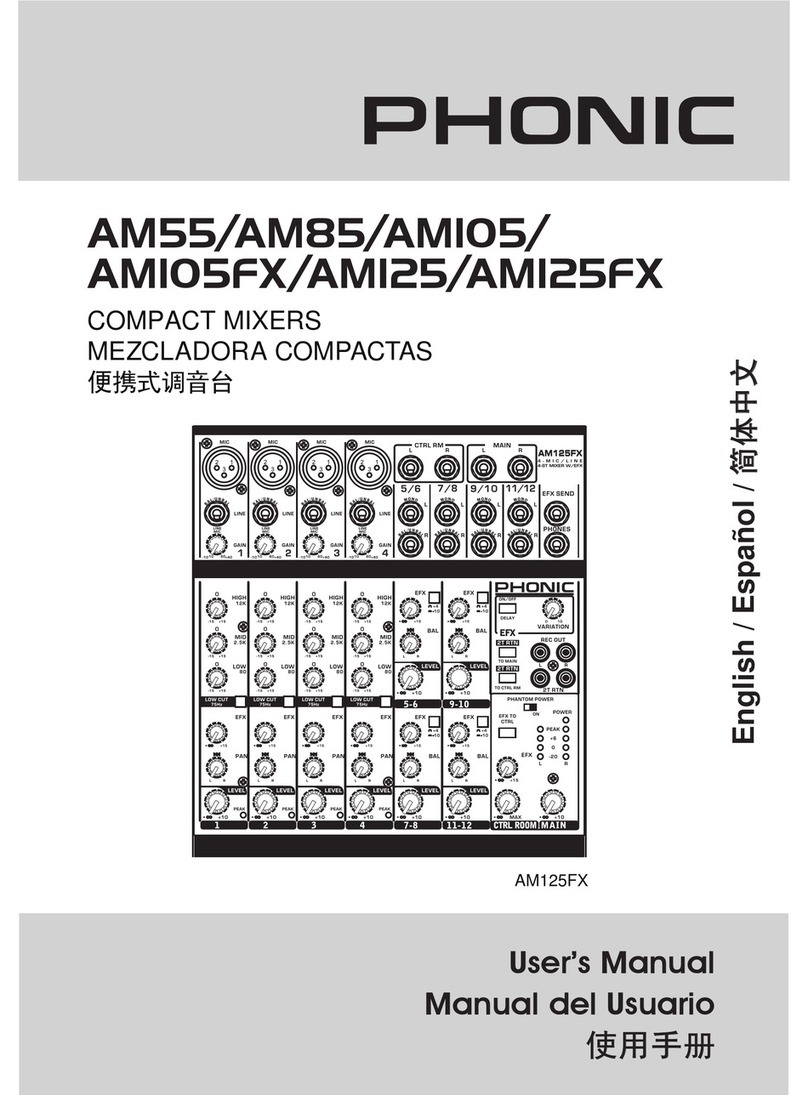
Phonic
Phonic AM55 User manual

Phonic
Phonic Powerpod 620 R User manual
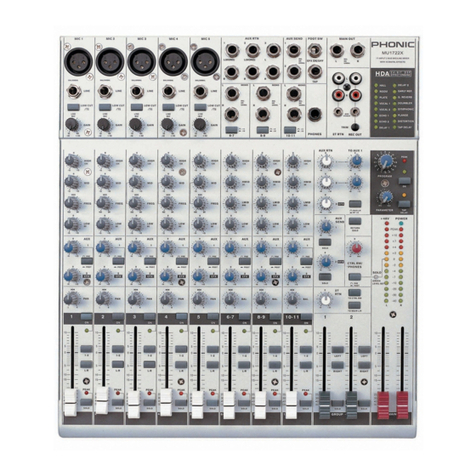
Phonic
Phonic MU1722X User manual

Phonic
Phonic MU1722X User manual
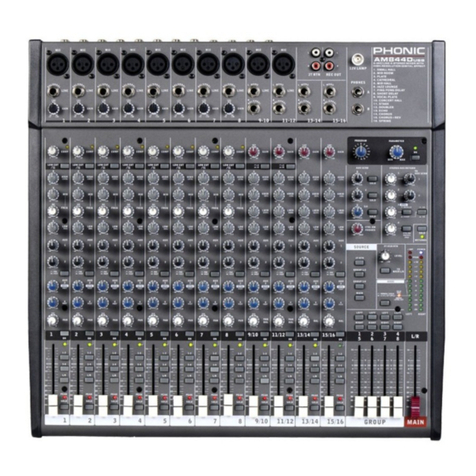
Phonic
Phonic AM844D User manual

Phonic
Phonic Powerprod 1080 User manual

Phonic
Phonic CELEUS 100 User manual

Phonic
Phonic HELIX BOARD 12 User manual

Phonic
Phonic MU 1002X User manual
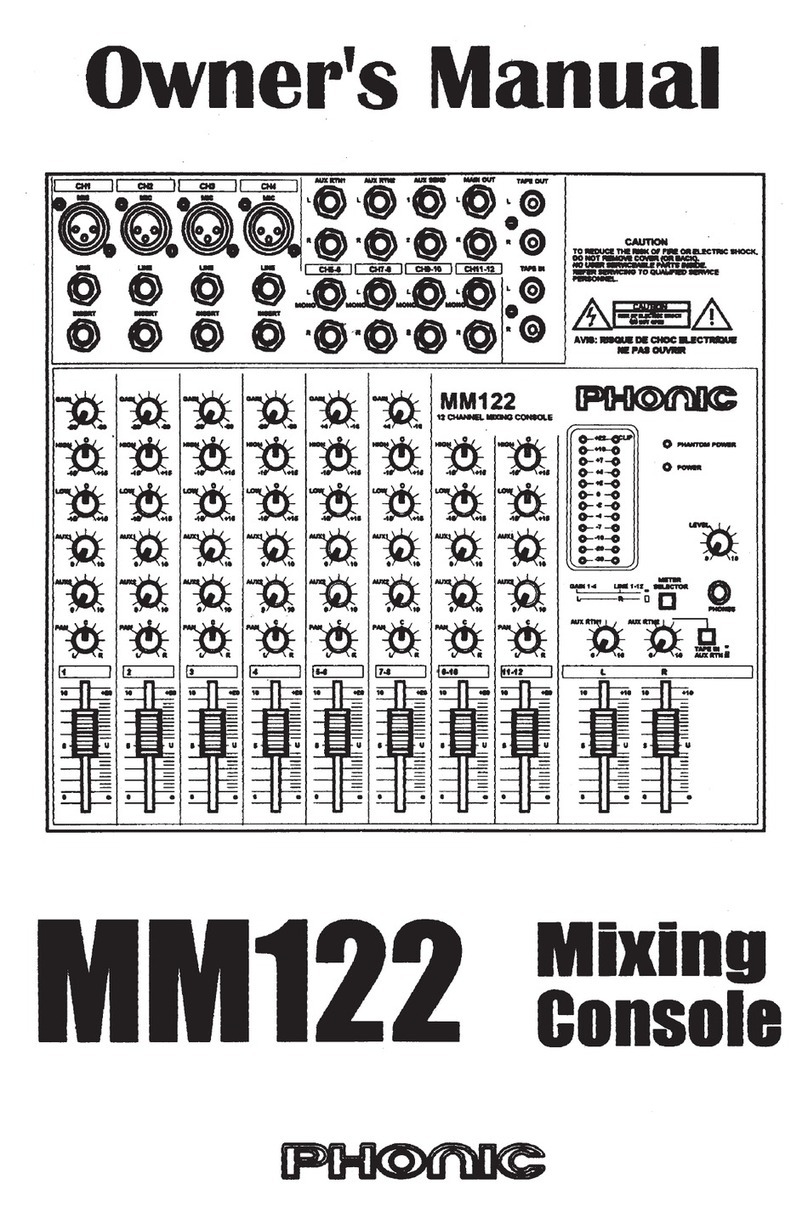
Phonic
Phonic MM122 User manual
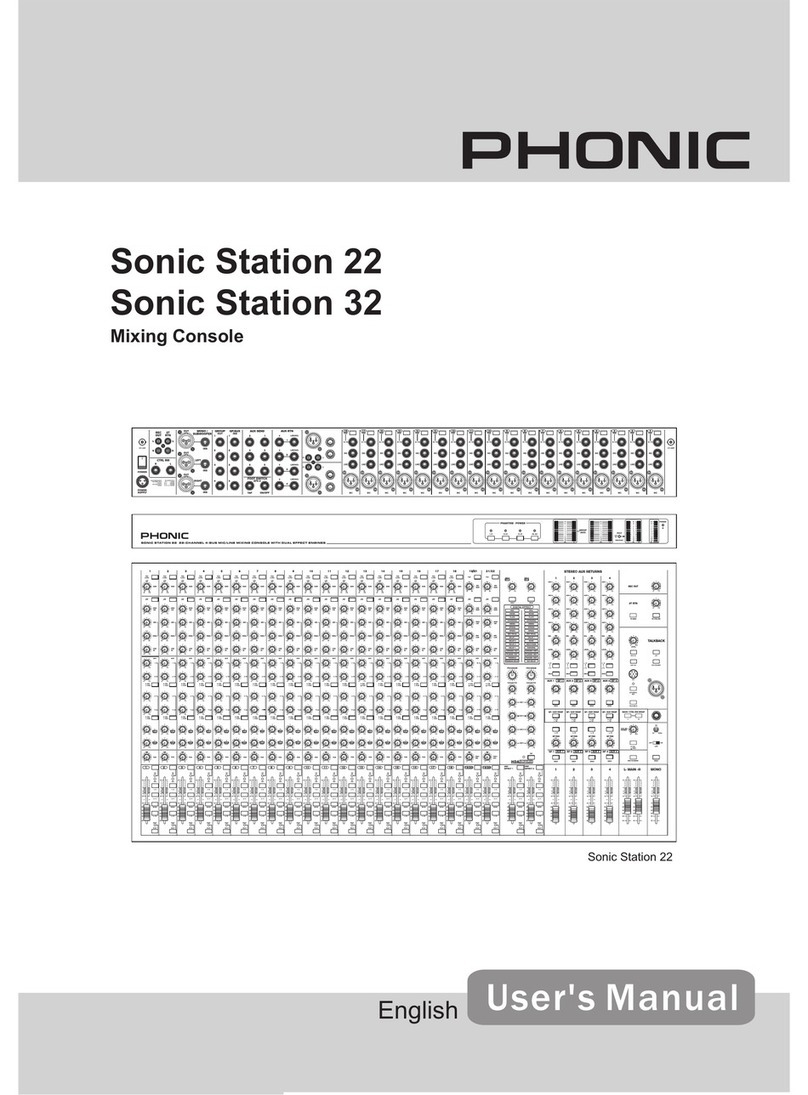
Phonic
Phonic Sonic Station 22 User manual
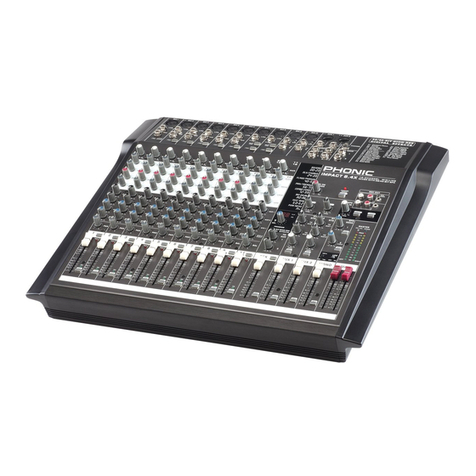
Phonic
Phonic IMPACT 8.4 User manual
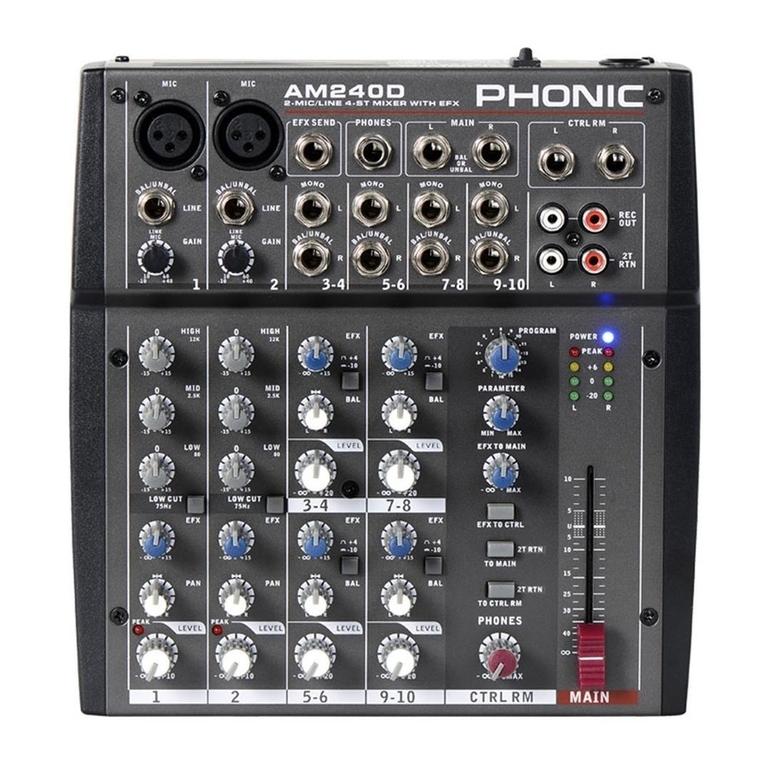
Phonic
Phonic AM 240 User manual
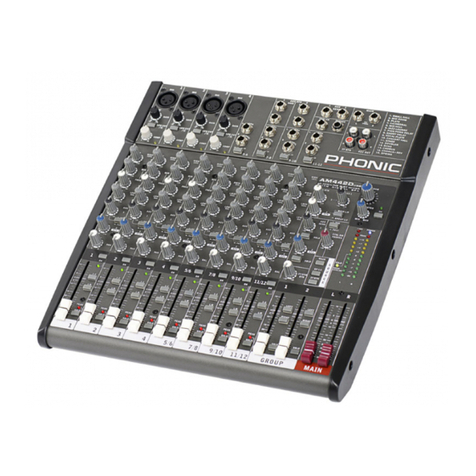
Phonic
Phonic AM442D User manual
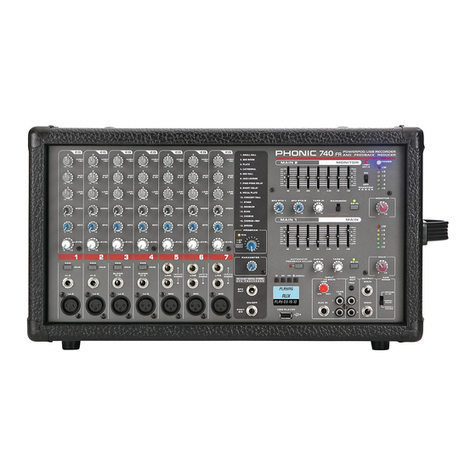
Phonic
Phonic Powerpod 740 Plus User manual

Phonic
Phonic POWERPOD1860 User manual
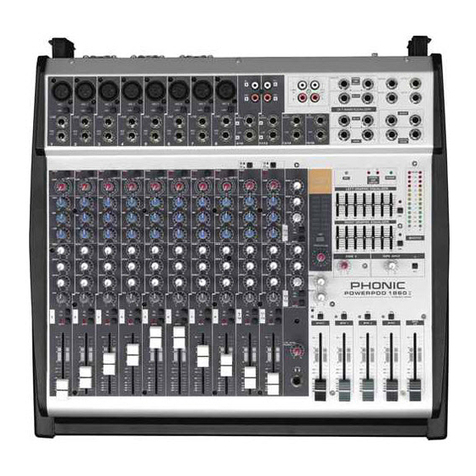
Phonic
Phonic POWERPOD 1860 II User manual

Phonic
Phonic AM440 User manual

